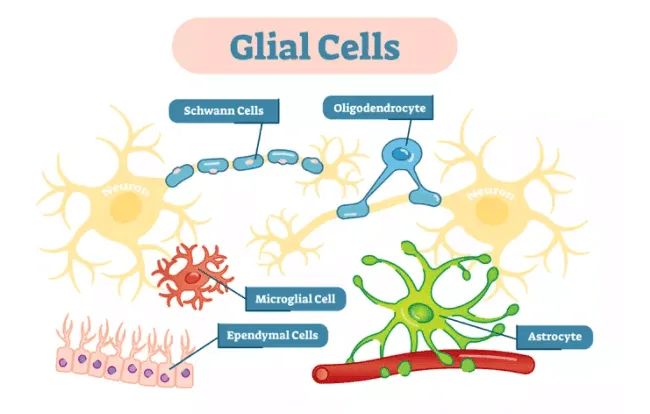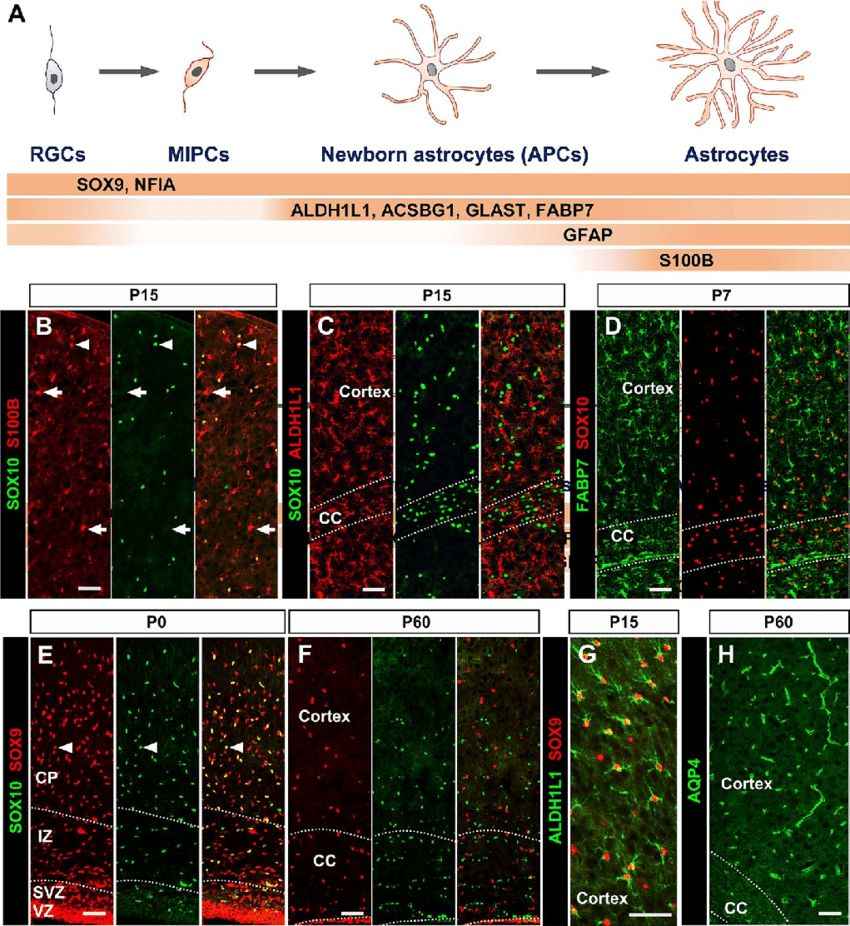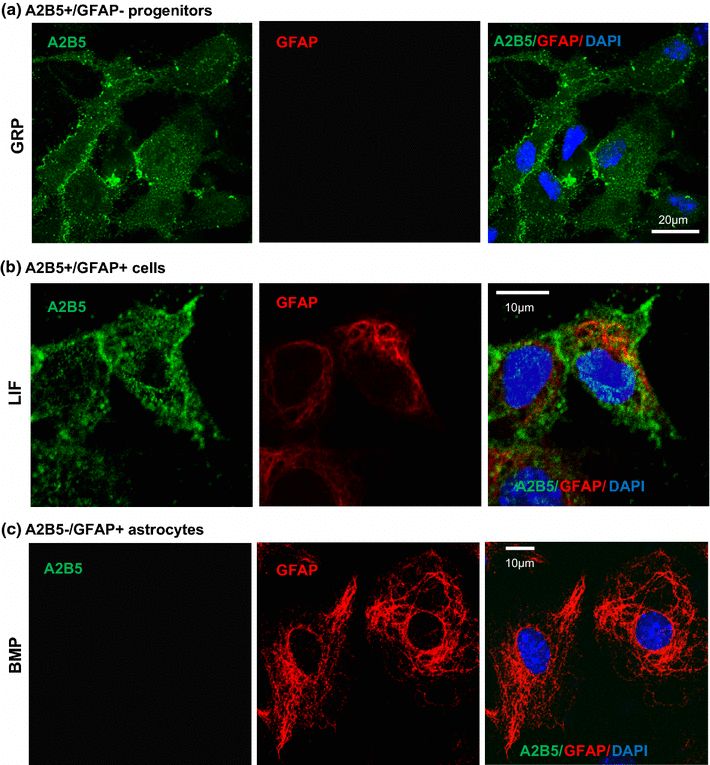Glial Lineage Markers
Related Symbol Search List
- Efnb2
- LINGO1
- LINGO4
- MAG
- NGFR
- OMG
- Rtn4r
- RTN4RL1
- Tnfrsf19
- Apolipoprotein E
- Carbonic anhydrase II
- CD44
- CLDN11
- CLDN12
- CSPG5
- FABP6
- FGFRL1
- GFAP
- GJA1
- LRRN1
- LRRN3
- METRNL
- MIB1
- MOG
- MSI1
- NES
- NFASC
- Olig1
- Olig2
- OLIG3
- PDGFRA
- PDXP
- PPP2CB
- PRG2
- PROKR2
- RNF5
- S100B
- SLC12A3
- SLC13A1
- SLC13A3
- SLC1A2
- SLC1A3
- SLC22A1
- SOX10
- SPARCL1
- VIM
Immunology Background
Background
Glial Cells
Glial cells, also known as neuroglia, are a type of support cell found in the central nervous system (brain and spinal cord) and peripheral nervous system. They provide physical and metabolic support to neurons, the main functional cells of the nervous system.
There are several types of glial cells, including astrocytes, oligodendrocytes, microglia, and ependymal cells. Astrocytes regulate the extracellular environment, provide nutrients to neurons, and help form the blood-brain barrier. Oligodendrocytes produce and maintain myelin, a fatty substance that insulates nerve fibers and allows for faster signal transmission. Microglia are the immune cells of the brain, responsible for clearing debris and pathogens. Ependymal cells line the cavities of the brain and spinal cord, producing cerebrospinal fluid.
Overall, glial cells play important roles in maintaining the health and function of the nervous system, and abnormalities in glial cell function have been implicated in various neurological disorders.

Glial Lineage Markers
Glial lineage markers are specific proteins, genes, or molecular tags that are used to identify and characterize glial cells in the nervous system. Glial cells, which include astrocytes, oligodendrocytes, and microglia, are non-neuronal cells that play essential roles in supporting, protecting, and maintaining the health of neurons. Glial lineage markers enable researchers to trace the lineage, development, and differentiation of these cells from their progenitor states to their mature forms.
Significance in Studying the Development and Function of Glial Cells
- Cellular Identification: Glial lineage markers allow researchers to identify and characterize different types of glial cells based on their lineage and specific functions. This is critical for understanding the diverse roles that glial cells play in the nervous system.
- Developmental Studies: By tracing the expression of lineage markers during development, researchers can study the differentiation pathways of glial progenitor cells into mature glial cells. This is important for understanding developmental disorders and the timing and regulation of glial cell formation.
- Pathological Studies: Changes in the expression of glial lineage markers can indicate alterations in glial cell function or pathology, such as in response to injury, neurodegeneration, or diseases like multiple sclerosis. Monitoring these markers helps researchers understand how glial cells contribute to disease processes.
- Cellular Interactions: Glial cells interact closely with neurons and other cells in the nervous system. Glial lineage markers help elucidate these interactions, which are vital for maintaining homeostasis, supporting neuronal function, and mediating inflammatory responses.
- Regenerative Medicine: Understanding glial lineage markers is crucial for developing therapies targeting glial cells for neuroprotection, repair, or regeneration, especially following injuries or in neurodegenerative diseases.
- Model Systems: Utilizing glial lineage markers in experimental models (such as transgenic mice) enables detailed studies of glial cell behavior in vivo, shedding light on complex tissue dynamics and responses to environmental changes.
Common Glial Lineage Markers
Some common categories of glial lineage markers include:
| Type | Details |
|---|---|
| Astrocyte Markers |
|
| Oligodendrocyte Markers |
|
| Microglia Markers |
|
| General Glial Markers |
|
By utilizing these diverse glial lineage markers, researchers can effectively identify, characterize, and study the different populations of astrocytes, oligodendrocytes, and microglia in the nervous system. These markers play a crucial role in advancing our understanding of glial cell biology, development, and function in health and disease.
 Fig.1 Schematic representation of glial cells in the CNS, along with their classification and representative marker genes. (Quan L, et al., 2022)
Fig.1 Schematic representation of glial cells in the CNS, along with their classification and representative marker genes. (Quan L, et al., 2022)Importance of Glial Lineage Markers in Disease Research
| Importance | Details |
|---|---|
| Disease Identification and Classification |
|
| Pathological Mechanisms |
|
| Therapeutic Targets |
|
| Biomarker Development |
|
| Mechanistic Insights |
|
By investigating glial lineage markers in disease contexts, researchers can uncover crucial insights into the role of glial cells in disease pathogenesis, identify potential therapeutic targets, develop diagnostic tools, and enhance our understanding of the complex interplay between glial cells and neuronal health in various neurological disorders.
Future Trends and Challenges
Research on glial lineage markers is increasingly recognized for its importance in understanding the roles of glial cells in the nervous system. Glial cells, including astrocytes, oligodendrocytes, and microglia, significantly influence neuronal function, brain homeostasis, and responses to injury or disease. Here are some future trends and challenges in glial lineage marker research, as well as emerging areas in neuroscience:
| Trends and Challenges | Details |
|---|---|
| Future Trends |
Advances in techniques such as single-cell RNA sequencing will provide more precise insights into the diversity and heterogeneity of glial cell types, allowing researchers to identify new glial lineage markers and better understand their functions.
There will be an increasing focus on the functional relevance of glial lineage markers in vivo. Understanding how these markers correlate with specific glial functions under physiological and pathological conditions will be crucial.
Future research may leverage innovative model systems, including organoids and advanced animal models, to study glial cell lineages and their roles in development and disease.
Understanding the communication between glial cells and other cell types (neurons and immune cells) will be essential. Research will focus on extrinsic factors that influence glial lineage development and their functional roles in the neural ecosystem.
Increasing interest in targeting glial cells for therapeutic purposes, particularly in neurodegenerative diseases and brain injuries, will lead to the development of glial lineage markers for identifying potential targets for regenerative therapies. |
| Challenges |
A major challenge is the lack of specific and universally accepted biomarkers for distinguishing between the different states and subtypes of glial cells, which can complicate interpretations of data related to glial function and pathology.
Glial cells are not static; they can change their phenotype in response to environmental cues. Characterizing this plasticity and its implications for glial lineage markers poses a significant research challenge.
Bridging the gap between glial and neuronal research remains a challenge. Combining insights from both fields is essential to fully understand the roles of glial cells in health and disease.
The integration of different research modalities (e.g., genetic, imaging, and electrophysiological techniques) to comprehensively study glial lineages will require interdisciplinary collaboration and advanced technological development.
Emerging areas, particularly those involving human-derived models and stem cell research, raise ethical questions that must be addressed, especially concerning the implications of manipulating glial cell lineages. |
| Emerging Areas in Neuroscience |
Research focused on glial cells' roles in neuroinflammation and their implications for neurodegenerative diseases and psychiatric disorders, such as Alzheimer's disease and multiple sclerosis.
Exploration of how glial cells influence synaptic function and plasticity, shedding light on their contributions to learning and memory.
Investigating the metabolic functions of glial cells, particularly how they support neuronal metabolism and energy homeostasis in the brain.
Understanding how glial cells contribute to psychiatric conditions (like depression and schizophrenia) offers new avenues for treatment strategies targeting glial dysfunction.
Research into glial lineage markers may provide insights into the aging process and the role of glial cells in age-related neurodegenerative diseases, potentially unveiling new therapeutic targets. |
In summary, glial lineage marker research is poised to make significant contributions to our understanding of brain function and pathology. Addressing challenges and embracing emerging areas in neuroscience will enhance our knowledge of glial biology and its implications for health and diseases of the nervous system.
Case Study
Case 1: Huang H, He W, Tang T, Qiu M. Immunological markers for central nervous system glia. Neurosci Bull. 2023;39(3):379-392.
In the central nervous system (CNS), oligodendrocytes, astrocytes, and microglia constitute the glial cell population, collectively representing over half of all CNS cells and playing indispensable roles in neural development and functionality. Research focusing on the determination of cell fate, differentiation, and functional specialization of these glial cells heavily relies on the accurate utilization of cell- or stage-specific molecular markers. Due to the varying specificity and sensitivity of cellular markers, it is crucial to carefully assess their suitability before application to prevent potential confusion. In this context, an updated compilation of established immunological markers for central glial cell labeling is presented, accompanied by discussions concerning the specificity to cell types and the dependency on developmental stages for their expression.
 Fig.1 Cellular markers for cells of astrocyte lineage.
Fig.1 Cellular markers for cells of astrocyte lineage.Case 2: Itokazu Y, Tajima N, Kerosuo L, et al. A2B5+/GFAP+ cells of rat spinal cord share a similar lipid profile with progenitor cells: a comparative lipidomic study. Neurochem Res. 2016;41(7):1527-1544.
Within the central nervous system (CNS), various cell types expressing glial fibrillary acidic protein (GFAP) are found, in addition to the predominant astrocytes. Stem cells and progenitor cells within the CNS also exhibit GFAP expression. To differentiate between two subsets of GFAP-expressing cells characterized by the presence or absence of A2B5 antigens, a study conducted lipidomic analyses on A2B5+/GFAP+ and A2B5-/GFAP+ cells derived from the rat spinal cord. Initially, A2B5+/GFAP- progenitors were treated with leukemia inhibitory factor (LIF) or bone morphogenetic protein (BMP) to prompt their transformation into A2B5+/GFAP+ cells or A2B5-/GFAP+ astrocytes, respectively. Mass spectrometry and gas chromatography were then employed to assess alterations in their phospholipid, sphingolipid, or acyl chain profiles.
Comparative analysis revealed that A2B5-/GFAP+ astrocytes exhibited elevated levels of ether phospholipids (particularly those containing arachidonic acid) and sphingomyelin in contrast to A2B5+/GFAP- progenitors, indicating characteristics of differentiation and a shift away from multipotency. Principal component analyses demonstrated that the lipid composition of A2B5+/GFAP+ cells retained similarities to A2B5+/GFAP- progenitors but differed from that of A2B5-/GFAP+ astrocytes. This study highlighted distinct lipid profiles between the two GFAP+ cell populations, with A2B5+/GFAP+ cells maintaining a lipid profile akin to progenitors rather than astrocytes. The regulated levels of lipids critical for signaling functions in differentiated cells might be necessary for progenitor cells, and the precursor lipid profiles could serve as an indicator of a cell population's differentiation capacity.
 Fig.2 The expressions of glial lineage markers A2B5 and GFAP.
Fig.2 The expressions of glial lineage markers A2B5 and GFAP.Related References
- Quan L, Uyeda A, Muramatsu R. Central nervous system regeneration: the roles of glial cells in the potential molecular mechanism underlying remyelination. Inflamm Regen. 2022;42(1):7.
- Huang H, He W, Tang T, Qiu M. Immunological markers for central nervous system glia. Neurosci Bull. 2023;39(3):379-392.
- Kriegstein A, Alvarez-Buylla A. The glial nature of embryonic and adult neural stem cells. Annu Rev Neurosci. 2009;32:149-184.
- Jurga AM, Paleczna M, Kadluczka J, Kuter KZ. Beyond the GFAP-astrocyte protein markers in the brain. Biomolecules. 2021; 11(9):1361.

